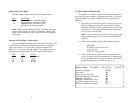
17
ESF: This stands for Extended Superframe Format, a line format
developed by AT&T. AT&T Technical Reference 54016 (TR
54016) defines the ESF, a format which is commonly used to
allow monitoring of the network interface performance over
the Facility Data Link (FDL). AT&T TR 62411 says, “the
Extended Superframe Format “extends” the DS1 superframe
structure from 12 to 24 frames…for a total of 4632 bits. It
redefines the 8 kb/s channel previously used exclusively for
terminal and robbed bit signaling synchronization.” The ESF
provides a 4 kb/s data link, called the FDL, which allows for
in-service monitoring and fast troubleshooting. Certain net-
work services require the ESF.
UNFRAMED:This is a special mode that allows you to achieve the
maximum possible data rate of 1.544 Mb/s (million bits per
second) by using the framing bits for data transmission. There
is no signaling or FDL. This is commonly used for campus
connections, and by the Federal government and the military.
This format is not to be used when connecting to a public car-
rier’s network without its permission. This provides one chan-
nel at a rate of 1.544 Mb/s. In addition, this format can be
used with external clocking.
Line Coding: B8ZS
(default)
Options: AMI, B8ZS, B7ZS.
AMI: Alternate Mark Inversion defines a pulse as a “mark”, a
binary one, as opposed to a zero. In a T1 (DS1) network con-
nection, signals are transmitted as a sequence of ones and
zeros. Ones are sent as pulses, and zeros are sent as
spaces, i.e., no pulse. Every other pulse is inverted from the
previous pulse in polarity, so that the signal can be effectively
transmitted. This means, however, that a long sequence of
zeros in the data stream will cause problems, since the
CSU/DSU receiving the signal relies on the signal to recover
the 1.544 Mb/s clock. To get around this problem, one method
is to limit the data rate per channel (known as a DS0,
because it is a 64 kb/s portion of the DS1 frame or super-
frame) to 56 kb/s and forcing a pulse in the last data bit to
ensure a minimum pulse density in the signal. If you must use
AMI with a DS0 data rate of 64 kb/s, you should ensure that
the data terminal equipment connected to the unit provides a
minimally acceptable pulse density. For this reason, there are
advantages to using B8ZS instead.
b
18
B8ZS: Bipolar violations occur when consecutive pulses are of
the same polarity. In B8ZS, or Bipolar Eight Zero Substitution,
bipolar violations are introduced deliberately to indicate that
eight zeros have been transmitted. This special encoding is
recognized by the receiver and decoded correctly. See AT&T
TR62411 Section 4.2.2 for a detailed description of B8ZS.
This enables information to be sent over a T1 connection
without any constraints on the data’s pulse density. This is the
most acceptable way to accomplish 64 kb/s on each DS0
channel.
B7ZS: This stands for Bipolar Seven Zero Substitution. Instead of
introducing bipolar violations, this method substitutes a one
for a zero in bit 7 (out of 8) of a DS0 channel when the data in
that channel are all zeros. This is a special form of AMI and is
compatible only with special equipment. For most applica-
tions, AMI or B8ZS will suffice.
DS0 Line Rate: 64kbps
(default)
Options: 64kbps, 56kbps
64kbps: Also known as Clear Channel, this takes full advantage
of the available bandwidth in a DS0 channel. Implementing it
usually requires B8ZS line coding. In certain cases, special
equipment may implement Clear Channel using AMI or B7ZS.
Consult the equipment manual for compatibility. Your carrier
will advise you on whether to use 64 or 56 kb/s. Campus
applications may not have such restrictions, enabling you to
use 64kbps. In Unframed format, the 24 DS0s and the fram-
ing bits are combined to provide 1.544Mb/s for your use.
56kbps: This uses only the first seven bits of the DS0, limiting the
data rate per DS0 channel to 56 kb/s. Your carrier will advise
you on whether to use 64 or 56 kb/s. This is not available
when using the Unframed format.
c


















